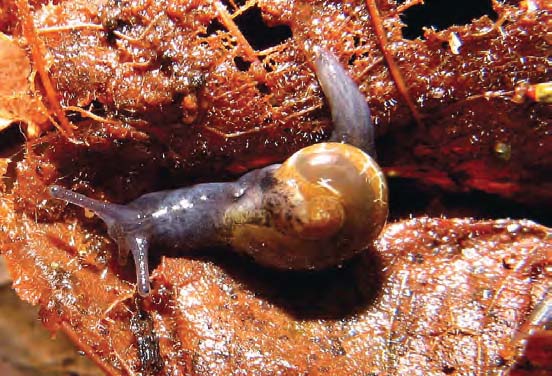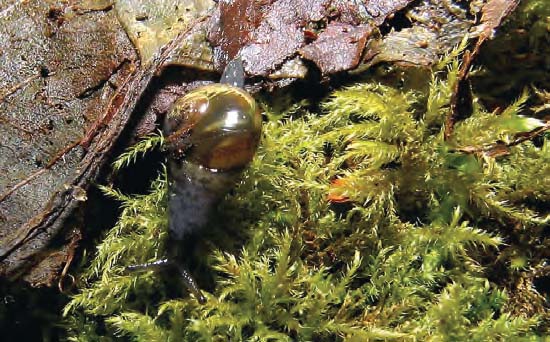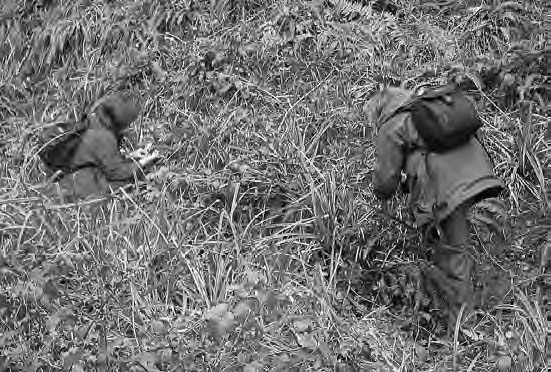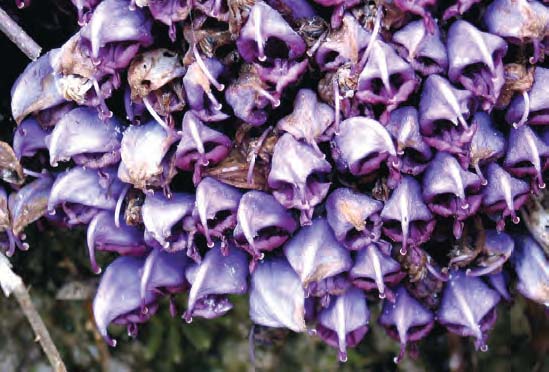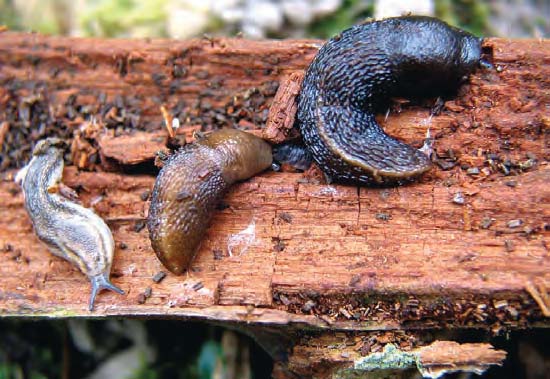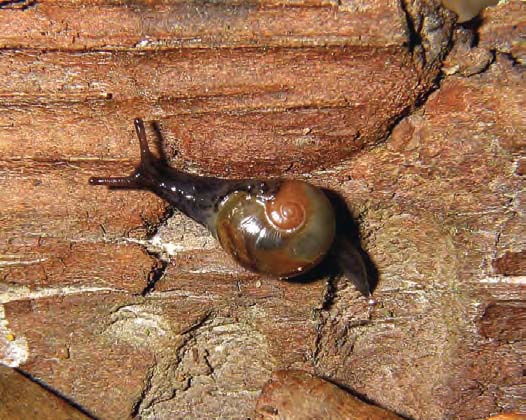|
The field meetings in the Ardingly area on 24-25 March were arranged as part of the ongoing Conch Soc project to determine the current distribution of the moisture-loving semislug Phenacolimax major, the intention being to look for this animal at sites where it has been found in the past and to search in promising habitat in other previously unworked areas. An early reconnaisance of the area armed with local grid references from the Society’s nonmarine database indicated that because of difficulties with car parking some sites would be impossible to visit at all quickly, but two or three could possibly be managed via a long route march from the Ardingly Reservoir car park. Dr Barry Colville also kindly supplied me with a few grid references in the area for potentially mollusc-rich sites. One of these was in an area of the National Trust’s Wakehurst Place estate not normally accessible to the public. The estate is immediately north of Ardingly Reservoir and is managed on behalf of the Trust by the Royal Botanic Gardens, who were extremely helpful in offering us escorted access to the site in question. Arrangements were put in place to hold the route march part of the meeting on the Saturday and the Wakehurst Place exploration on the Sunday. On the Saturday two members began at the Reservoir car park, in dull overcast weather with persisted for the entire day, and walked along the eastern side of the reservoir towards the road bridge, searched without success in the wet woodland on the other side of the reservoir and then made our way eastwards along the road to the roadside site where P. major had been found under stones in 1973, only to find that the potential site had been converted into a small layby and there were no stones of any kind. Only a few paces from this spot was a notice declaring permitonly access to the Loder Valley nature reserve belonging to the Royal Botanic gardens at Wakehurst Place. We ventured a short distance along the pathway in search of what we thought might be suitable habitat, and found a small stream traversing a patch of soft mud with clumps of pendulous sedge Carex pendula and considerable amounts of oak leaf litter. We turned over a few dead leaves, and there it was! By this time two hours had gone by. The next nearest historic site for P. major lay along what we knew to be an extremely narrow winding road with sharp gradients, serious traffic and no footways. A spot of map reading indicated that we could walk onward along the path at the edge of the reservoir and we would eventually meet up with the road again anear the desired site. Other suitable sites might be found on the walk. There was a small patch of wet woodland along the way, but no promising sites were found. We did eventually reach the road just beyond Balcombe Mill and noticed a steep wooded slope to the north of the road with a stream running down to a wet alder carr area, next to a pool at the top of the reservoir that could easily have been the mill pond for a nearby mill. The stream bed was gravelly with wettish black soil above, and not a trace of sand. We found live Zonitoides excavatus and Cochlicopa lubrica on the slope, and Deroceras laeve and two specimens of Phenacolimax major among oak and sweet chestnut litter close to plants of opposite-leaved golden saxifrage Chrysosplenium oppositifolium and pendulous sedge and near a small stream and a patch of waterlogged mud at the foot of an old fallen tree. Five and a half hours later and we had only checked two of the sites, and it was still a long way back to the car. The following day was again dull and overcast. Seven of us assembled in the car park at Wakehurst Place where we made our acquaintance with Steven Robinson, the warden of the Loder Valley nature reserve which forms part of the Wakehurst estate. Wakehurst Place is owned by the National Trust but the garden there is leased to and operated by the Royal Botanic Gardens Kew. Part of the estate beyond the garden is farmed for red deer, and it came as quite a surprise to be taken along a narrow pathway with high wire netting fences to each side. Beyond this was a large tract of wet woodland with similar high wire fences. It was now beginning to dawn on us why the mollusc-rich site that Barry had investigated was now a no-public-access area. Steven unlocked the gate and took us through into the woodland which was wet alder carr with coppiced hazel understorey and much opposite leaved golden saxifrage. The site was very level and waterlogged with streams running through, and surprisingly little leaf litter considering the tree density. There was no pendulous sedge or other types of herbaceous plants that would have offered good hiding places for molluscs, and the soil there was much sandier than it had appeared at first sight. Despite the unpromising appearance of the site, 25 live mollusc species were recorded. As the warden needed to be elsewhere from lunch time onward, I quickly gathered a quantity of leaf litter from Barry’s original grid reference and we exited the wood via another gate which had been specially installed so that the late Francis Rose could regularly monitor a community of rare mosses on a rock outcrop. We now found ourselves next to the Visitor Education Centre which had a particularly convenient set of picnic benches for hungry conchologists to lunch at. The Loder Valley nature reserve could now be accessed via a locked gate, but this had a keypad combination lock and could be opened provided one knew the code number. Peter and Pam Wilson briefly investigated an area at the start of the reservoir near to the Education Centre and found live Sphaerium corneum and an empty shell of Anodonta anatina. After lunch the seven of us entered the reserve and immediately came across a bank of purple flowers growing straight out of the soil, with no sign of any leaves. Peter Wilson said that it was an exotic toothwort parasitic on tree roots that had escaped from the botanic garden (Lathraea clandestina, apparently). We continued down the path into the reserve, and as soon as we encountered a stream began our search. We were finding different molluscs now, and it was not long before we encountered our first Phenacolimax major, in wet oak leaf litter among a patch of bluebells. The second one was near a log above a stream in a narrow valley containing hazel coppice and much dead wood. The third one was two metres above the stream in the middle of a pendulous sedge plant among plentiful oak leaf litter. The fourth was where there was very moist bare clay soil. The valley of the third stream we came to also looked fairly promising. A patch of pendulous sedge among fallen timber with oak and hazel leaf litter yielded yet another P. major. Peter and Pam had a further look at the margin of the reservoir not far from the third stream with their water sampling equipment and found live Pisidium personatum and Potamopyrgus antipodarum as well as a range of water beetles and mayfly and caddis larvae. The leaf litter samples from Barry’s original site beyond the deer enclosure contained fairly high quantities of fine sand which suggested that a flood event had occurred there some time during the winter. The samples contained only 3 species over and above what we had originally found at the site; these were Succinea putris, Carychium minimum in large numbers, and a single dead shell of Acicula fusca. Our grateful thanks are due to Steven Robinson and the Royal Botanic Gardens authorities at Wakehurst Place for access to the Loder reserve. |
1 Semislug Phenacolimax major at lower end of Loder reserve
2 Semislug Phenacolimax major near Balcombe Mill
3 Working a stream valley in the Loder reserve
4 Purple toothwort Lathraea clandestina in Loder reserve
5 Limax maximus and adult and juvenile Limax cinereoniger in Loder reserve
6 Semislug Phenacolimax major at top end of Loder reserve |
Table 1 Mollusca found at Wakehurst Place on 25 March 2007
| Wet woodland enclosure at TQ 331315 | Leaf litter collected at TQ 332315 | Lakeside near Wakehurst Place visitor education centre | First stream at top of Loder Valley reserve TQ 332302 | Third stream in Loder Valley reserve TQ 333307 | |
| Potamopyrgus antipodarum | L | ||||
| Anodonta anatina | L | ||||
| Sphaerium corneum | L | ||||
| Pisidium personatum | L | ||||
| Acicula fusca | S | ||||
| Carychium minimum | L | ||||
| Carychium tridentatum | L | L | L | ||
| Succinea putris | L | ||||
| Oxyloma pfeifferi | L | ||||
| Cochlicopa lubrica | L | L | |||
| Columella aspera | L | ||||
| Columella edentula | L | L | L | ||
| Discus rotundatus | L | L | |||
| Arion subfuscus | L | ||||
| Arion intermedius | L | ||||
| Arion distinctus | L | L | |||
| Arion silvaticus | L | ||||
| Arion fasciatus | L | ||||
| Phenacolimax major | L | L | |||
| Vitrea crystallina | L | L | L | ||
| Nesovitrea hammonis | L | ||||
| Nesovitrea hammonis | L(juv) | ||||
| Aegopinella nitidula | L | L | L | ||
| Aegopinella pura | L | L | |||
| Oxychilus alliarius | L | ||||
| Oxychilus helveticus | L | L | |||
| Zonitoides excavatus | L | ||||
| Zonitoides nitidus | L | L | |||
| Limax cinereoniger | L | ||||
| Lehmannia marginata | L | ||||
| Deroceras laeve | L | ||||
| Deroceras reticulatum | L | ||||
| Euconulus alderi | L | ||||
| Euconulus alderi | S | ||||
| Euconulus fulvus | L | L | L | ||
| Cochlodina laminata | S | ||||
| Cochlodina laminata | L | L | |||
| Macrogastra rolphii | L | L | L | ||
| Clausilia bidentata | L | ||||
| Trochulus hispidus | L | L | |||
| Cepaea hortensis | L | L |

